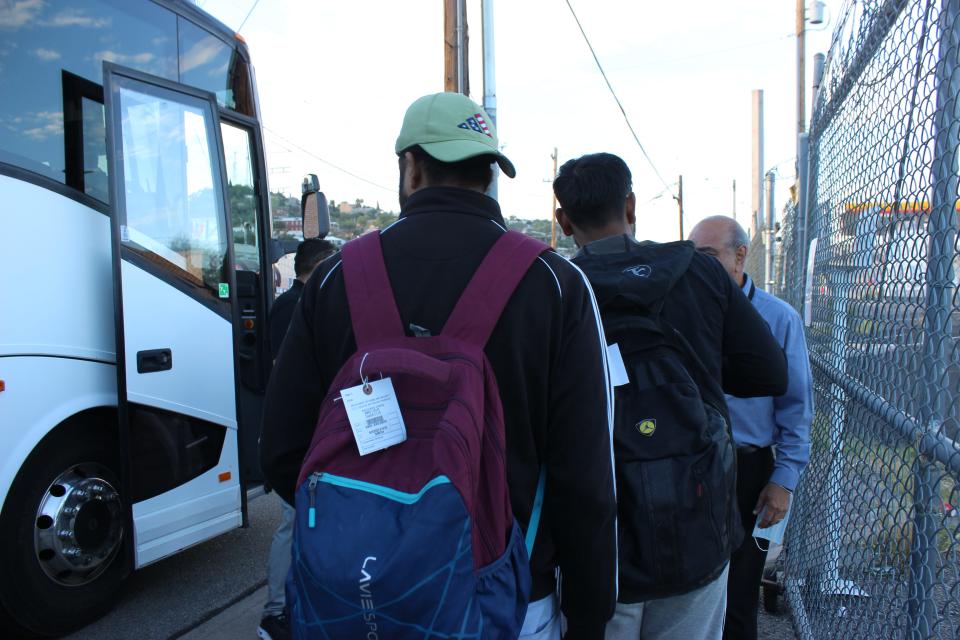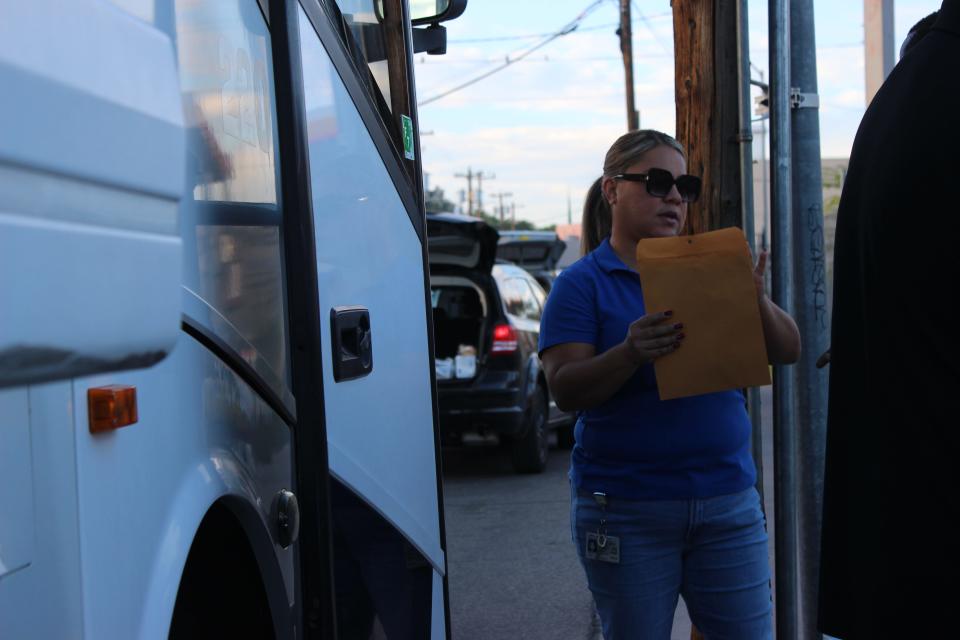A record 3.6 million migrants entered the US with parole status. Here's what to know
The number of migrants who entered and are living in the United States under temporary or conditional status has reached record levels as President Joe Biden's administration centers programs such as humanitarian parole as major components of its border management strategy.
At least 3.6 million migrants have entered the United States under parole in the past three years. About 2.3 million are living in the country under various conditional programs implemented by the U.S. Department of Homeland Security that provide them "twilight status," according to an analysis from the Migration Policy Institute and the federal government's own data. But at least 1.2 million more migrants also entered with temporary parole status that has since lapsed.
They are referred to as "twilight" because these statuses allow migrants to remain in the United States for temporary periods of time, ranging from a matter of weeks to up to two years, but do not offer a path to permanent residency or citizenship. The idea is that, once the status lapses and unless they have applied for other programs that allow parolees to stay in the country, they will have to leave the U.S. or be subject to deportation.
Approximately 2.3 million migrants with "twilight" status — such as the Deferred Action for Childhood Arrivals which were established under executive authority in 2012 — have active parole status and are eligible to apply for work authorization in the United States. They can renew their work permits for the duration of their respective programs.
The Temporary Protected Status parole program has been around since Congress established it in 1990. It applies to certain migrants from 15 countries, including a re-designation last month for Afghans and Venezuelans. They total about 611,000 at the moment, according to the Migration Policy Institute, but this number is likely to grow by up to 472,000 under the expanded guidelines for Venezuelans.
The Cuban, Haitian, Nicaraguan, and Venezuelan Parole Programs began in January and total nearly 209,000 recipients according to U.S. Citizenship and Immigration Services, which has the authority to grant parole to migrants under the Immigration and Nationality Act.
Mario Russell, the executive director for the pro-immigration Center for Migration Studies of New York said the Biden administration has had to find creative solutions to manage the arrival of migrants since the country's immigration laws have not changed in more than 30 years.
"They've got a problem with old laws and old systems," he said. "If it's the best we have, then I think it's appropriate to sort of work through and find how can you do this in the margins, with other tools that are available if Congress is not able to do that."
U.S. Border Patrol agents have also processed and released into the United States 1,280,894 migrants under humanitarian release along the U.S.-Mexico border in the past three years, according to U.S. Customs and Border Protection statistics.

Humanitarian releases have increased in recent weeks in communities along the U.S.-Mexico border amid an increase in apprehensions and capacity limits at border holding facilities. Migrant encounters along the southern U.S. border have been on the rise. With one more month to go until the end of the fiscal year, it is almost assured that the total for 2023 will surpass last year's record of 2.38 million encounters.
Migrants processed under humanitarian release receive parole for shorter periods, typically about 60 days. They are not eligible for work authorization in the country and instead are placed into removal proceedings after they are released into communities along the southern border. They can file for asylum during that time, but will otherwise be added to a 2.6 million-long queue in U.S. immigration court that can take years to adjudicate individual cases.
While the estimated population of migrants that entered the U.S. under parole totals 3.6 million under available data, some of those numbers may overlap. For example, a migrant from Venezuela who entered the U.S. under humanitarian release and was placed into removal proceedings can apply for Temporary Protected Status if they entered prior to July 31.
Infant migrant death: Infant girl dies after Nogales Border Patrol agent couldn't understand her mother
That number also does not include the number of migrants paroled out of U.S. Immigration and Customs Enforcement custody. The most recent data available from October to December show that ICE paroled 23,682 migrants. That is a fraction of the more the 197,000 migrants actively enrolled in ICE's Alternative to Detention program. However, the number of active enrollments changes over time, with older participants removed to make way for new arrivals, according to ICE.
"Even though we've seen more irregular migration into the United States and more of those migrants may have a need, may have an opportunity to stay in the country for different reasons, including different policies by the Biden administration, there also have been a lot of expulsion and removals," said Ariel Soto Ruiz, a senior policy analyst with the nonpartisan Migration Policy Institute.
Soto Ruiz authored a report for MPI published in August on the size of the unauthorized population in the U.S. The report estimates that between 2008 and 2021, Immigration and Customs Enforcement officials removed 4.7 million migrants from the country.
More recently, the Department of Homeland Security has boosted its ability to deport migrants more quickly. Take for example the Cuban, Honduran, Nicaraguan and Venezuelan Parole Program, which began in January. It caps the number of migrants from those countries allowed into the U.S. under humanitarian parole at 30,000 each month. But it also allows U.S. immigration officials to return to Mexico each month up to 30,000 migrants from those four countries who did not apply for the CHNV program.
Then on May 12, the DHS ended enforcement of Title 42, a pandemic health rule used to turn away 2.8 million migrants at the southern U.S. border during the three-year period it was in place. When Title 42 ended, DHS expanded fast-track deportations by screening migrants who did not claim or did not pass credible fear interviews directly at the border and deporting them under expedited removal. The process bypasses the formal removal proceedings through the U.S. Department of Justice's Executive Office for Immigration Review, which houses the country's backlogged immigration courts.
Asylum seekers: What happens when they enter the US?
From May until mid-September, U.S. immigration officials deported 253,000 migrants from the United States to 152 countries, including about 36,000 migrants traveling as families. ICE's Enforcement and Removal Operations division has also doubled the number of deportation flights around the globe. About 110,000 of those migrants were deported under expedited removal, according to DHS.
The Department of Homeland Security announced on Sept. 20 additional steps it has taken to ease bottlenecks and congestion at border processing and holding facilities. This includes the deployment of an additional 800 National Guard troops to the southern border to help with logistics and processing. They added space to hold an additional 3,250 migrants at holding facilities along the border, bringing the total capacity to 23,000.
The department's own watchdog office has warned Secretary Alejandro Mayorkas that several of the DHS agencies may not be able to track the migrants released into the country. On average, DHS is releasing into the U.S. around 60,000 migrants each month, the department's Office of the Inspector General said in a 35-page report published on September 6.
The report said investigators were unable to properly track nearly one in five migrants that Border Patrol released between March 2021 and August 2022 because the addresses were either missing, invalid or not a residence.
The inspector general's report said Immigration and Customs Enforcement, which manages migrants' cases after the Border Patrol releases them, was unable to validate some of their addresses, too. In one ICE field office, deportation officers spent an average of three minutes per case each year. The document cited how quickly agents have to process migrants out of border holding facilities as one of the main reasons.
"DHS may unknowingly release migrants, including children, to potentially unsafe conditions or smuggling operations," said the report signed by Joseph Cuffari, the inspector general.
The Department of Homeland Security disagreed with the report. The department said they have implemented online tools to facilitate information sharing between various federal agencies operating along the border, including an online change of address form with built-in address verification.
Maricopa County sheriff: Paul Penzone beat Joe Arpaio. Undoing his legacy proved much tougher
Critics of the Biden administration's policies such as Lora Ries, a former DHS official who now works for the conservative think tank the Heritage Foundation, worry that humanitarian parole status is being abused. She pointed to a rise in migrant encounters at the border as proof that the expansion of parole programs eligible for work authorization only entices more people to come to the border seeking a work permit.
"It gives this hint of, oh, they're coming here lawfully because we're allowing them in through ports and we're paroling them in," Ries said. "They are exploiting the very confusing immigration law, and just assuming that if you keep lawful pathways enough, people will believe it. But he (Biden) doesn't have the constitutional authority to grant this visa-like benefits for aliens."
There is broad consensus from supporters and critics alike that the system along the U.S.-Mexico border is not working well. Humanitarian releases are especially straining the work of nonprofits and local governments in the U.S.-Mexico border region.

Their arrival in cities such as New York and Chicago is straining resources in those places. The Biden administration is ramping up efforts to get migrants who are authorized to work legally in these destination cities to apply for permits and to speed up processing to get them working.
Citizenship and Immigration Services has sent out 1.4 million texts and emails to eligible migrants from several programs: the Cuban, Honduran, Nicaraguan and Venezuelan Parole Program, Temporary Protected Status, and for migrants processed at the border under the CBP One phone app. They are able to apply for work authorization right away, and the agency is sending 50 employees to New York this month to get eligible individuals to apply.
Russell with the Center for Migration Studies of New York said the work permits allow newly arrived migrants to get on their feet more quickly, and to alleviate pressures on the cities they are settling in such as New York City. Prior to joining the Center, Russell worked for over two decades with Catholic Charities of New York and helped welcome at least 116,000 migrants that have arrived in the city since last year.
"People have come through the shelter system for a temporary period of time and then move on, and create and develop their opportunities," Russell said. "The misconception is that there are somehow hundreds of thousands of people in different cities in the United States who are just sitting around doing nothing to move their lives forward. Quite the contrary."
Have any news tips or story ideas about immigration in the Southwest? Reach the reporter at [email protected], or follow him on X (formerly Twitter) at @RafaelCarranza.
Support local journalism. Subscribe to azcentral.com today.
This article originally appeared on Arizona Republic: Record 3.6 million migrants entered the US with parole status
Solve the daily Crossword

